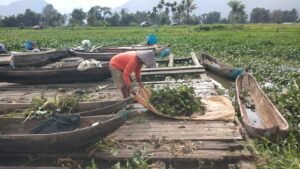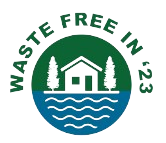
Introduction
Water hyacinth is an invasive aquatic plant that causes serious environmental problems worldwide. It spreads rapidly, blocking waterways, reducing fish populations, and lowering water quality. This study explores how turning water hyacinth into biochar—a type of charcoal used to improve soil—can be an eco-friendly way to manage the plant while benefiting farmers.
Turning Water Hyacinth into Biochar
Researchers collected water hyacinth from Lake Tana in Ethiopia, dried it, and then heated it in a process called pyrolysis. This was done at 300°C for 40 minutes, producing biochar with a 44.6% yield. The process removed harmful substances while preserving essential nutrients that are beneficial for plants.
Economic Benefits
Biochar can reduce farmers’ dependence on expensive chemical fertilizers by improving soil fertility naturally. In the study, soil treated with 2,500 kg per hectare of water hyacinth biochar (WHBC) helped increase Teff crop yields. Teff, a staple grain in Ethiopia, grew as well with biochar as it did with mineral fertilizers, making WHBC a cost-effective alternative for farmers.
Using WHBC also helps create new economic opportunities by turning an unwanted plant into a valuable product. Communities affected by water hyacinth can collect and process it into biochar, selling it as a sustainable soil enhancer.
Environmental Benefits
Water hyacinth is a major threat to ecosystems, but using it for biochar turns a problem into a solution. Instead of letting the plant clog lakes and rivers, converting it to biochar helps restore water systems while improving soil health.
WHBC improves soil by:
- Increasing soil nutrients: It contains essential elements like nitrogen (N), phosphorus (P), calcium (Ca), and potassium (K), which support healthy plant growth.
- Improving soil structure: It makes the soil better at holding water and nutrients, reducing the need for chemical fertilizers.
- Reducing soil acidity: Many farmlands have acidic soil, which lowers crop production. WHBC, with its high pH, helps neutralize soil acidity.
- Lowering heavy metal contamination: The biochar effectively binds harmful metals, preventing them from being absorbed by crops.
How WHBC Performs in Agriculture
To test the effectiveness of WHBC, scientists applied different amounts to soil and compared the results with mineral fertilizers. They found that 2,500 kg per hectare of WHBC produced nearly the same Teff grain yield as chemical fertilizers, making it a natural and sustainable option.
The study also found that biochar improves soil’s ability to store nutrients and support beneficial microbes, which helps plants grow healthier. Long-term use of WHBC could reduce the need for synthetic fertilizers, making farming more environmentally friendly.
Conclusion
Converting water hyacinth into biochar is an innovative way to tackle environmental problems while benefiting farmers. It reduces water pollution, enhances soil fertility, and provides a low-cost alternative to chemical fertilizers. The study suggests that large-scale biochar production from water hyacinth could help improve food security and promote sustainable agriculture.
Got questions?
